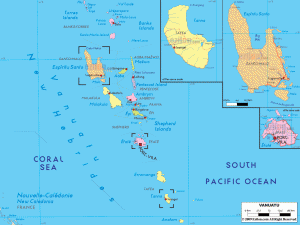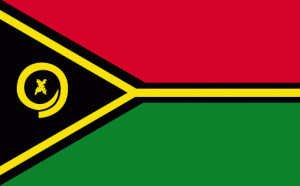Vanuatu, an archipelago of approximately 83 islands is situated in the South-western Pacific Ocean, about 1,750 kilometers east of Australia and 500 kilometers northeast of New Caledonia. The Republic of Vanuatu lies between latitude 13degrees south and 23degrees south and longitude 166 degrees east and 172degrees east. The total land area is approximately 12,274 square kilometers and the territorial waters cover 450,000 square kilometers.
The climate varies considerably from tropical to subtropical according to exposure to trade winds and elevation. The north is wetter and more humid than the south. The average midday temperature in Port Vila is 29 degrees C. in summer and 25 degrees C. in winter. Rainfall is about 235 centimeters (90 inches) annually. Both the climate and arable soils are very conducive to the development of land and livestock husbandry.
Population
The total population of Vanuatu is estimated to be more than 300,000 people. About 95% of the population is indigenous known as “Ni-Vanuatu”. The other segment of the population includes people of different nationalities, such as Australians, New Zealanders, Europeans, Asians and other Pacific Islanders. Over 20% live in the two large cities of Port Vila and Luganville. More than 40,000 people live in the capital city of Port Vila.
Brief History
Vanuatu or New Hebrides as it was known in the condominium days has been inhabited for over 4000 years was discovered by Europeans in May 1606 by the Spanish Explorer Captain, Pedro Fernandez de Quiros. After de Quiros followed Captain James Cook in 1774, French and English missionaries, traders, and black birders who took local people as slaves to work in the Sugar cane plantations in Queensland, Australia. Most of these people never returned home.
After some 74 years of joint “Condominium” rule between Britain and France, Vanuatu finally received its independence on the 30th July 1980. On December 1994, the 11 Local Government Councils were changed into 6 provinces, giving them more autonomy to decide on what is best for their people, though still under the rule of the national Government.
Political and Administrative Setup
The Republic of Vanuatu is an independent parliamentary democracy, with 52 members of Parliament, for which general elections are held every 4 years. The most recent national election was held in October 2022.
 The head of state is the President of the Republic, who is elected for a period of five years by an electoral college consisting of Members of Parliament and the Presidents of the Provincial Councils. The current President of the Republic of Vanuatu was elected in July 2022.
The head of state is the President of the Republic, who is elected for a period of five years by an electoral college consisting of Members of Parliament and the Presidents of the Provincial Councils. The current President of the Republic of Vanuatu was elected in July 2022.
The Prime Minister and the 12 co-members of the council of ministers oversee the administration of Vanuatu’s 13 government ministries.
The Constitution provides for executive and legislative arms of government, and the judiciary. The President is Vanuatu’s Head of State.
The judiciary consists of the Supreme Court with a Chief Justice and a Magistrates Court. The highest court is the Court of Appeal.
Vanuatu is a full member of the British Commonwealth, the French League of Nations, the United Nations, Agence de Co-operation Culturelle et Technique, the South Pacific Bureau for Economic Co-operation (SPEC), the Secretariat of the Pacific Community, the World Bank and the Asian Development Bank.
A Brief Glance at Vanuatu
Population: 300,000+ (2020)
Capital: Port Vila
Surface area: 12,274 sq km
Time zone: GMT +11 hrs
Business language: English/French
Political Status: Parliamentary Republic
Head of State: President
Date of independence: 30th July 1980
Legal system: Primarily English Common Law
Nominal GDP: US$79109 million (2011)
Inflation: 0.8% (2014)
Currency: Vatu (VUV)
Major industrial sectors: Tourism, agriculture, offshore financial centre, fisheries, forestry
Exports: Copra, Coconut Oil, Kava, Beef, Cocoa, Vanilla, Coffee
Major export markets: European Union, Australia, New Caledonia, Japan New Zealand
Imports: Machinery and Transport Equipment, Food & Live Animals, Fuels
Major import markets: Australia, Japan, Singapore, New Zealand, Fiji
 Location, Climate and Geography
Location, Climate and Geography